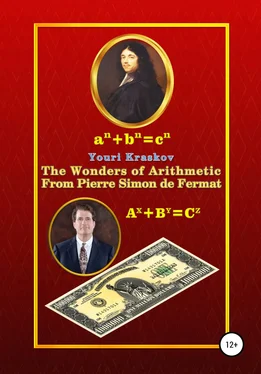p i 2=(x 2+y 2) 2=(x 2−y 2) 2+(2xy) 2
i.e. the square of such a prime will also be the sum of two squares. From here appears the truly grandiose scientific discovery of Fermat: 53
All primes of type 4n+1 can be uniquely decomposed into the sum of two squares, i.e. the equation p=4n+1=x 2+y 2has a unique solution in integers. But all other primes of type 4n−1 cannot be decomposed in the same way.
In the Fermat's letter-testament it was shows how this can be proven by the descent method. However, Fermat’s proof was not preserved and Euler who solved this problem had to use for this all his intellectual power for whole seven years. 54Now already the solution to the Diophantine task seems obvious. If among the prime factors of number c there is not one related to the type 4n+1, then the number c 2cannot be decomposed into the sum of two squares. And if there is at least one such number p i, then through the Pythagoreans’ identity it can be obtain:
c 2= N 2p i 2= (Nx) 2+(Ny) 2
where x= u 2−v 2; y=2uv; a=N(u 2−v 2); b=N2uv
The solution is obtained, however it clearly does not satisfy Fermat because in order to calculate the number N you need to decompose the number c into prime factors, but this task at all times was considered as one of the most difficult of all problems in arithmetic. 55Then you need to calculate the numbers x, y i.e. solve the problem of decomposing a prime of type 4n+1 into the sum of two squares. To solve this problem, Fermat worked almost until the end of his life.
It is quite natural that when there is a desire to simplify the solution of the Diophantine task, a new idea also arises of obtaining a general solution of the Pythagoras’ equation a 2+ b 2= c 2in a way different from using the identity of Pythagoreans. As it often happens, a new idea suddenly arises after experienced strong shocks. Apparently, this happened during the plague epidemic of 1652 when Fermat managed to survive only by some miracle, but it was after that when he quite clearly imagined how to solve the Pythagoras’ equation in a new way.
However, the method of the key formula for Fermat was not new, but when he deduced this formula and immediately received a new solution to the Pythagoras equation, he was so struck by this that he could not for a long time come to oneself. Indeed, before that to obtain one solution, two integers must be given in the Pythagoreans' identity, but with the new method, it may be obtained minimum three solutions with by only one given integer.
But the most surprising here is that the application of this new method does not depend on the power index and it can be used to solve equations with higher powers i.e. along with the equation a 2+b 2=c 2can be solved in the same way also a n+b n=c nwith any powers n>2. To get the final result, it remained to overcome only some of the technical difficulties that Fermat successfully dealt with. And here such a way it appeared and became famous his remark to the task 8 of Book II Diophantus' "Arithmetic":
Cubum autem in duos cubos, aut quadrato-quadratum in duos quadrato-quadratos, et generaliter nullam in infinitum ultra quadratum potestatem in duas eiusdem nominis fas est dividere cuius rei demonstrationem mirabilem sane detexi. Hanc marginis exiguitas non caperet .
See Pic. 3 and the translation at the end of Pt. 1.
The reconstructed FLT proof presented here contains new discoveries unknown to today’s science. However, from this it does not follows that proof becomes difficult to understand. On the contrary, it is precisely these discoveries that make it possible to solve this problem most simply and easily. The phenomenon of the unprovable FLT itself would not have appeared at all if the French Academy of Sciences had been founded during the lifetime of P. Fermat. Then he would become an academician and published his scientific researches and among his theorems in all arithmetic textbooks there would be also such a most ordinary theorem:
For any given natural number n>2 , there is not a single triplet of natural numbers a, b and c, satisfying the equation
a n+b n=c n(1)
To prove this statement, suppose that a, b, c satisfying to (1) exist and then based on this, we can get the all without exception solutions to this equation in general form. To this aim we use the key formula method, in which one more equation is added to the initial equation so that it becomes possible to obtain solution (1) in a system of two equations. In our case the key formula is:
a+b=c+2m (2)
where m is a natural number.
To obtain formula (2) we note that a≠b since otherwise 2a n=c nwhat is obviously impossible. Consequently, an-1+b n-1)>c n-1whence (a+b)>c. Since in (1) cases with three odd a, b, c, as well as one odd and two even are impossible, the numbers a, b, c can be either all even or two odd and one even. Then from (a + b) > c follows formula (2) where the number 2m is even 56.
At first, we verify the effectiveness of the method for the case n = 2 or the Pythagoras’ equation a 2+b 2=c 2. Here the key formula (2) applies and you can get a solution to the system of equations (1), (2) if you substitute one into another. To simplify it, we will square both sides of (2) to make the numbers in (1) and (2) proportionate. Then (2) takes the form:
{a 2+b 2−c 2}+2(c−b)(c−a)=4m 2(3)
Substituting the Pythagoras’ equation in (3), we obtain:
A iB i=2m 2(4)
where taking into account the formula (2):
A i=c−b=a−2m; B i=c−a=b−2m (5)
Now we decompose the number 2m 2into prime factors to get all the A iB ioptions. For primes m there are always only three options: 1×2m 2=2×m 2=m×2m. In this case A 1=1; B 1=2m 2; A 2=2; B 2=m 2; A 3=m; B 3=2m. Since from (5) it follows a=A i+2m; b=B i+2m; and from (2) c=a+b−2m; then we end up with three solutions:
1. a 1=2m+1; b 1=2m(m+1); c 1=2m(m+1)+1
2. a 2=2(m+1); b 2=m(m+2); c 2= m(m+2)+2 (6)
3. a 3=3m b 3=4m; c 3=5m
Equations (6) are the solutions of the Pythagoras’ equation for any natural number m. If the number m is composite, then the number of solutions increases accordingly. In particular, if m consists of two prime factors, then the number of solutions increases to nine 57. Thus, we have a new way of calculating all without exception triples of Pythagoras’ numbers, while setting only one number m instead of two numbers that must be specified in the Pythagoreans identity. However, the usefulness of this method is not limited only to this since the same key formula (2) is also valid for obtaining a general solution of equations with higher powers.
Using the method to obtain solutions of (1) for the case n=2, it is also possible to obtain solutions for n>2 by performing the substitution (1) in (2) and exponentiating n both sides of (2). To do this, first we derive the following formula 58:
(x+y) n=z n=zz n-1=(x+y)z n-1=xzz n-2+yz n-1=
x(x+y)z n-2+yz n-1=x 2zz n-3+y(z n-1+xz n-2)+…
(x±y) n=z n=x n±y(x n-1+x n-2z+x n-3z 2+…+xz n-2+z n-1) (7)
We will name the expression in brackets consisting of n summand a symmetric polynomial and we will present it in the form (x ++ z) nas an abridged spelling. Now using formula (7), we will exponentiating n both sides of formula (2) as follows.
[a−(c−b)] n=a n+{b n−c n+(c n−b n)}−(c−b)[a n-1+a n-22m+…
+ a(2m) n-1+(2m) n-1]=(2m) n
Now through identity
(c n−b n)=(c−b)(c n-1+c n-2b+…+cb n-2+b n-1) we obtain:
Читать дальше





![Theresa Cheung - The Dream Dictionary from A to Z [Revised edition] - The Ultimate A–Z to Interpret the Secrets of Your Dreams](/books/692092/theresa-cheung-the-dream-dictionary-from-a-to-z-r-thumb.webp)






